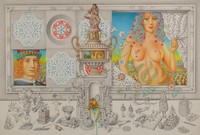Igor Tulpanov
 Biography Biography
Magnificent 47
galleries:Painting
archive:The panels by Igor Tulpanov
|
 Igor Tulpanov is one of the most sophisticated artists of our time, a classic of modern art, a master with sensitive existential nerve. Igor Tulpanov is one of the most sophisticated artists of our time, a classic of modern art, a master with sensitive existential nerve.
Tulpanov beatifies art. He incorporates stylistic elements from Leonardo da Vinci, Hieronymus Bosch and Jan van Eyck. From panel to panel Tulpanov repeats certain symbols – statues of pagan gods, glasses, books, tears, eggs and mirrors, but he puts different meaning in each symbol depending on the painting.
What remains the same in all works, is incredible detail, the compositions’ logic, the precision of thin brush strokes, the artists’ infatuation with the world and its mysteries. Tulpanov’s acute intuition and ear for beauty assist him in forming compositions unmistakably. His innate sense of order and harmony helps him to find ways to put even disparate forms and objects in perfect balance.
Igor Tulpanov is a master of graphic and painting. He delicately uses oil and acrylic paint, ink and watercolor, and has no equal in colored pencil drawing.
This is especially evident in the 20 panels of the Magnificent 47 series made with the artist’s favorite colored pencils. Each painting of the series strikes with color, clever composition, craftsmanship and patterning, the originality of the subject matter and mystique.
Tulpanov’s imagery contains unexpected juxtapositions, humor, familiarity, mystery and a wide variety of objects and characters drawn from the artist’s vast knowledge of art history and architecture, as well as his love for the surrounding world. His symbols derive from various civilizations – Western, Japanese, Chinese, Egyptian, Russian and Greco-Roman. Tulpanov, however, always renders these images with his own vision.
 Take Mozart and Mona Liza panel from his Magnificent 47 series, for example. The dictionary definition of Absolutism serves as a written verbatim there. Absolutism says an object does not have to have physical presence in order to actually exist. The eternal act of self-consciousness, which we call “self,” gives all things existence. Perhaps, the Absolutism definition on the Mozart and Mona Lisa panel aims to provoke thought in the viewers or have them ponder on the meaning of absolutism. But the rest of the painting wants to be visually enjoyed – for colors, shapes, lines, patterns, and images, without being searched for hidden meanings. Take Mozart and Mona Liza panel from his Magnificent 47 series, for example. The dictionary definition of Absolutism serves as a written verbatim there. Absolutism says an object does not have to have physical presence in order to actually exist. The eternal act of self-consciousness, which we call “self,” gives all things existence. Perhaps, the Absolutism definition on the Mozart and Mona Lisa panel aims to provoke thought in the viewers or have them ponder on the meaning of absolutism. But the rest of the painting wants to be visually enjoyed – for colors, shapes, lines, patterns, and images, without being searched for hidden meanings.
The Magnificent 47 builds on the experience of previous civilizations and old masters, as well as on contemporary art. Through his paintings, Tulpanov raises the altar in the name of beauty based on eight postulates of excellence: Beauty and Harmony, Strength and Splendor, Skill and Knowledge, Recognition, Non-Repetition, Strangeness and Intrigue, Mastery and, of course, Talent.
The artist devoted 35 years to studying painting and searching for answers to eternal questions. He put another 12 years to create 24 unique panels, combining great skill with great intelligence.
Tulpanov’s paintings are pleasant to look at; there are never any horrible images, nor are there images of horror. The artist simply wants his works to help viewers find a key to the world of beauty, charm and happiness with its variety, grandeur and harmony.
|